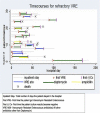Feasibility of Population Health Analytics and Data Visualization for Decision Support in the Infectious Diseases Domain: A pilot study
- PMID: 27437065
- PMCID: PMC4941864
- DOI: 10.4338/ACI-2015-12-RA-0182
Feasibility of Population Health Analytics and Data Visualization for Decision Support in the Infectious Diseases Domain: A pilot study
Abstract
Objective: Big data or population-based information has the potential to reduce uncertainty in medicine by informing clinicians about individual patient care. The objectives of this study were: 1) to explore the feasibility of extracting and displaying population-based information from an actual clinical population's database records, 2) to explore specific design features for improving population display, 3) to explore perceptions of population information displays, and 4) to explore the impact of population information display on cognitive outcomes.
Methods: We used the Veteran's Affairs (VA) database to identify similar complex patients based on a similar complex patient case. Study outcomes measures were 1) preferences for population information display 2) time looking at the population display, 3) time to read the chart, and 4) appropriateness of plans with pre- and post-presentation of population data. Finally, we redesigned the population information display based on our findings from this study.
Results: The qualitative data analysis for preferences of population information display resulted in four themes: 1) trusting the big/population data can be an issue, 2) embedded analytics is necessary to explore patient similarities, 3) need for tools to control the view (overview, zoom and filter), and 4) different presentations of the population display can be beneficial to improve the display. We found that appropriateness of plans was at 60% for both groups (t9=-1.9; p=0.08), and overall time looking at the population information display was 2.3 minutes versus 3.6 minutes with experts processing information faster than non-experts (t8= -2.3, p=0.04).
Conclusion: A population database has great potential for reducing complexity and uncertainty in medicine to improve clinical care. The preferences identified for the population information display will guide future health information technology system designers for better and more intuitive display.
Keywords: Health information systems; big data; information display; population decision support systems; uncertainty.
Conflict of interest statement
All authors declare that there are no conflicts of interest.
Figures
Similar articles
-
The future of Cochrane Neonatal.Early Hum Dev. 2020 Nov;150:105191. doi: 10.1016/j.earlhumdev.2020.105191. Epub 2020 Sep 12. Early Hum Dev. 2020. PMID: 33036834
-
Identifying complexity in infectious diseases inpatient settings: An observation study.J Biomed Inform. 2017 Jul;71S:S13-S21. doi: 10.1016/j.jbi.2016.10.018. Epub 2016 Nov 3. J Biomed Inform. 2017. PMID: 27818310 Free PMC article.
-
Toward Designing Information Display to Support Critical Care. A Qualitative Contextual Evaluation and Visioning Effort.Appl Clin Inform. 2016 Oct 5;7(4):912-929. doi: 10.4338/ACI-2016-03-RA-0033. Appl Clin Inform. 2016. PMID: 27704138 Free PMC article.
-
Novel displays of patient information in critical care settings: a systematic review.J Am Med Inform Assoc. 2019 May 1;26(5):479-489. doi: 10.1093/jamia/ocy193. J Am Med Inform Assoc. 2019. PMID: 30865769 Free PMC article.
-
Concurrence of big data analytics and healthcare: A systematic review.Int J Med Inform. 2018 Jun;114:57-65. doi: 10.1016/j.ijmedinf.2018.03.013. Epub 2018 Mar 26. Int J Med Inform. 2018. PMID: 29673604
Cited by
-
Data Science Trends Relevant to Nursing Practice: A Rapid Review of the 2020 Literature.Appl Clin Inform. 2022 Jan;13(1):161-179. doi: 10.1055/s-0041-1742218. Epub 2022 Feb 9. Appl Clin Inform. 2022. PMID: 35139564 Free PMC article. Review.
-
Improving Team-Based Decision Making Using Data Analytics and Informatics: Protocol for a Collaborative Decision Support Design.JMIR Res Protoc. 2019 Nov 27;8(11):e16047. doi: 10.2196/16047. JMIR Res Protoc. 2019. PMID: 31774412 Free PMC article.
-
Artificial Intelligence-Powered Smartphone App to Facilitate Medication Adherence: Protocol for a Human Factors Design Study.JMIR Res Protoc. 2020 Nov 9;9(11):e21659. doi: 10.2196/21659. JMIR Res Protoc. 2020. PMID: 33164898 Free PMC article.
-
Analysing genome sequences and associated metadata during the COVID-19 pandemic in Iraq revealed points to be improved: An observational retrospective study.PLoS One. 2025 Jun 30;20(6):e0326750. doi: 10.1371/journal.pone.0326750. eCollection 2025. PLoS One. 2025. PMID: 40587452 Free PMC article.
-
Perioperative and ICU Healthcare Analytics within a Veterans Integrated System Network: a Qualitative Gap Analysis.J Med Syst. 2017 Aug;41(8):118. doi: 10.1007/s10916-017-0762-z. Epub 2017 Jul 6. J Med Syst. 2017. PMID: 28685304
References
-
- Mandl KD, Kohane IS. Escaping the ehr trap — the future of health it. New England Journal of Medicine 2012; 366(24): 2240-2242. doi:doi:10.1056/NEJMp1203102. - PubMed
-
- Mitka M. Physicians cite problems with ehrs. JAMA 2014; 311(18): 1847–1847. doi:10.1001/jama.2014.5030.
Publication types
MeSH terms
Grants and funding
LinkOut - more resources
Full Text Sources
Other Literature Sources
Medical




